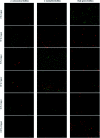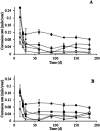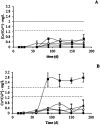The role of surface copper content on biofilm formation by drinking water bacteria
- PMID: 35530774
- PMCID: PMC9072912
- DOI: 10.1039/c9ra05880j
The role of surface copper content on biofilm formation by drinking water bacteria
Abstract
Copper pipes are conventionally used to supply tap water. Their role in biofilm prevention remains to be understood. This study evaluates the ability of selected surface materials with different copper contents (0, 57, 79, 87, 96, 100% of copper) to control biofilm formation and regrowth. Further experiments were performed to assess copper leaching and corrosion under conditions mimicking real plumbing systems. Acinetobacter calcoaceticus and Stenotrophomonas maltophilia isolated from a drinking water distribution system were used as model bacteria. All the copper materials showed positive results on the control of single and dual species biofilms presenting high reductions of bacterial culturability > 4 log CFU per cm2. The antimicrobial action of the selected materials seem not to be related to copper leaching or to the formation of reactive oxygen species. However, bacterial-copper contact demonstrated damage to bacterial membranes. The alloy containing 96% copper was the most promising surface in reducing biofilm culturability and viability, and was the only surface able to avoid the regrowth of single species biofilms when in contact with high nutrient concentrations. The alloy with 87% copper was shown to be unsuitable for use in chlorinated systems due to the high copper leaching observed when exposed to free chlorine. The presence of viable but non-culturable bacteria was remarkable, particularly in dual species biofilms. The overall results provide novel data on the role of copper alloys for use under chlorinated and unchlorinated conditions. Copper alloys demonstrated comparable or even higher biofilm control effects than elemental copper surfaces.
This journal is © The Royal Society of Chemistry.
Conflict of interest statement
Authors declare no conflict of interest.
Figures







Similar articles
-
Influence of surface copper content on Stenotrophomonas maltophilia biofilm control using chlorine and mechanical stress.Biofouling. 2020 Jan;36(1):1-13. doi: 10.1080/08927014.2019.1708334. Epub 2020 Jan 30. Biofouling. 2020. PMID: 31997661
-
The impact of potassium peroxymonosulphate and chlorinated cyanurates on biofilms of Stenotrophomonas maltophilia: effects on biofilm control, regrowth, and mechanical properties.Biofouling. 2023 Aug-Sep;39(7):691-705. doi: 10.1080/08927014.2023.2254704. Epub 2023 Oct 9. Biofouling. 2023. PMID: 37811587
-
Chlorine and Monochloramine Disinfection of Legionella pneumophila Colonizing Copper and Polyvinyl Chloride Drinking Water Biofilms.Appl Environ Microbiol. 2019 Mar 22;85(7):e02956-18. doi: 10.1128/AEM.02956-18. Print 2019 Apr 1. Appl Environ Microbiol. 2019. PMID: 30683743 Free PMC article.
-
Impact of biofilm formation and detachment on the transmission of bacterial antibiotic resistance in drinking water distribution systems.Chemosphere. 2018 Jul;203:368-380. doi: 10.1016/j.chemosphere.2018.03.143. Epub 2018 Mar 22. Chemosphere. 2018. PMID: 29627603 Review.
-
Copper Surfaces in Biofilm Control.Nanomaterials (Basel). 2020 Dec 11;10(12):2491. doi: 10.3390/nano10122491. Nanomaterials (Basel). 2020. PMID: 33322518 Free PMC article. Review.
Cited by
-
Biofilm formation potential and chlorine resistance of typical bacteria isolated from drinking water distribution systems.RSC Adv. 2020 Aug 24;10(52):31295-31304. doi: 10.1039/d0ra04985a. eCollection 2020 Aug 21. RSC Adv. 2020. PMID: 35520667 Free PMC article.
-
Robust immobilization of anionic silver nanoparticles on cellulose filter paper toward a low-cost point-of-use water disinfection system with improved anti-biofouling properties.RSC Adv. 2021 Jan 25;11(9):4873-4882. doi: 10.1039/d0ra09152a. eCollection 2021 Jan 25. RSC Adv. 2021. PMID: 35424442 Free PMC article.
-
Effect of pipe material and disinfectant on active bacterial communities in drinking water and biofilms.J Appl Microbiol. 2025 Jan 6:lxaf004. doi: 10.1093/jambio/lxaf004. Online ahead of print. J Appl Microbiol. 2025. PMID: 39762135 Free PMC article.
-
Synthesis, and characterization of metallic glassy Cu-Zr-Ni powders decorated with big cube Zr2Ni nanoparticles for potential antibiofilm coating applications.Sci Rep. 2022 Aug 1;12(1):13163. doi: 10.1038/s41598-022-17471-x. Sci Rep. 2022. PMID: 35915147 Free PMC article.
-
Zwitterionic poly(sulfobetaine methacrylate)-based hydrogel coating for drinking water distribution systems to inhibit adhesion of waterborne bacteria.Front Bioeng Biotechnol. 2023 Feb 21;11:1066126. doi: 10.3389/fbioe.2023.1066126. eCollection 2023. Front Bioeng Biotechnol. 2023. PMID: 36896012 Free PMC article.
References
-
- NRC, Drinking water distribution systems: Assessing and reducing risks, N.R.C., Washington, DC, 2006
-
- Critchley M. M. Cromar N. J. McClure N. Fallowfield H. J. Water Sci. Technol.: Water Supply. 2002;2:81–87.
-
- Simões L. C. Simões M. RSC Adv. 2013;3:2520–2533. doi: 10.1039/C2RA22243D. - DOI
LinkOut - more resources
Full Text Sources
Other Literature Sources
Miscellaneous

